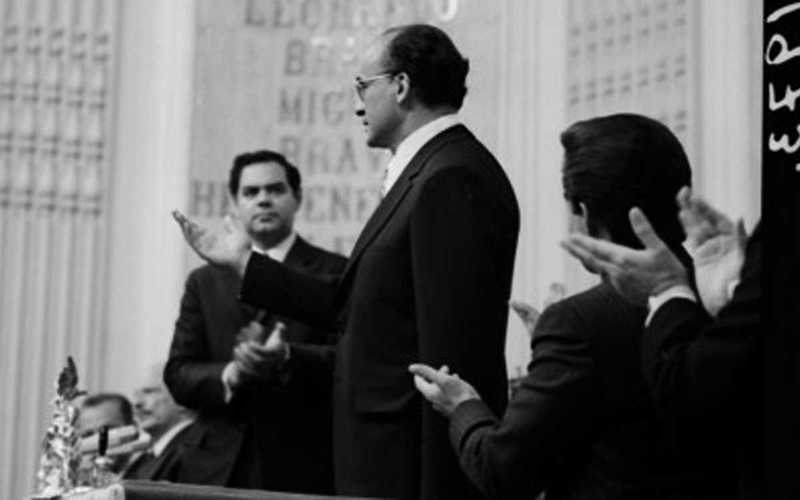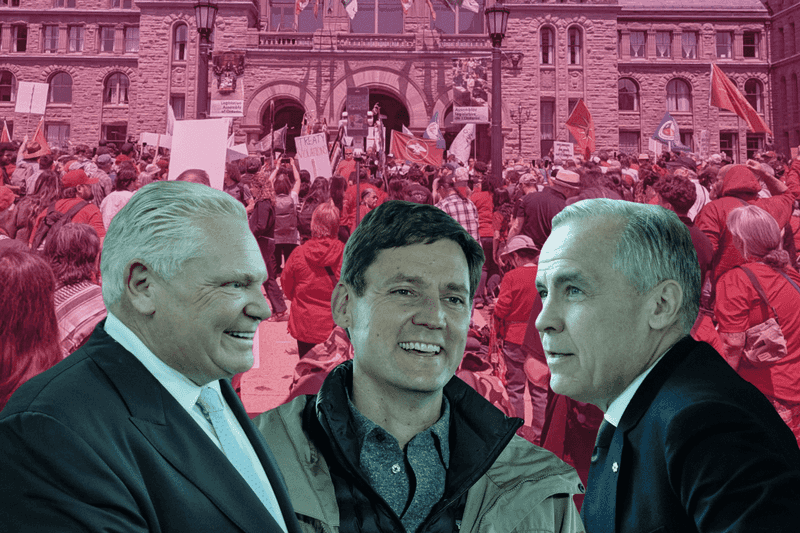
In April of 1972, the Mexican president came before an international audience to call for a radical reorientation of the global economy in which his country was embedded. Luis Echeverría used his speech at the 1972 UN Conference on Trade and Development (UNCTAD) in Santiago, Chile to enumerate the principles that would anchor a new Charter of Economic Rights and Duties of States: “freedom to dispose of natural resources; the right of every nation to adopt the economic structure it considered most suitable and to treat private property as the public interest required; renunciation of the use of economic pressures; subjection of foreign capital to domestic laws; prohibition of interference by supranational corporations in the internal affairs of States; abolition of trade practices that discriminated against the exports of non-industrial nations; economic advantages proportionate to levels of development; treaties guaranteeing stable and fair prices for basic products; transfer of technology; and greater economic resources for long-term, untied aid.”1 This was a remarkably comprehensive vision for a fairer world economy, one that would limit the privileges of multinational corporations, redistribute resources from North to South, and level the playing field regarding trade and investment. The proposal provided the basis for what would go on, over complicated negotiations during the next two years, to constitute the demand for a New International Economic Order (NIEO). The Charter was, undoubtedly, a consummate Third Worldist vision—but it was promulgated by a leader already infamous for his violent repression at home, the intellectual architect of multiple student massacres in Mexico City and a brutal Dirty War in the Mexican countryside. How, then, should we remember this moment, and what lessons can we draw from it?
The history of the Charter of Economic Rights and Duties of States—what was called in Mexico the “Carta Echeverría”—demonstrates that a turn back to these earlier moments of South-South coordination in search of lessons for our current struggles requires a closer read. Particularly if we seek to understand how these efforts were organized collectively, and how the alternative futures imagined by those collectives were foreclosed, we need a deeper analysis of the interests, motivations, and compromises pursued by what one scholar has called the “state manager architects” of Third Worldism.2 It is necessary to move beyond the universalist aspirations of the NIEO project, embodied in the pronouncements of political figures and diplomats at international meetings and the remarkable texts of UN declarations and plans of action. In order to understand how the project for the NIEO was organized, and how it was defeated, we must be more attentive to the interplay between domestic and international politics among the many players, North and South—and therefore both the front-stage and back-stage dynamics that shaped how various state representatives understood their place in the capitalist world system and approached their attempts to radically reform the rules of global economic governance.
Even recent scholarly reappraisals of the campaign that produced the Charter and the NIEO declaration remain largely front-stage stories, based on speeches and pronouncements at international meetings as well as published contemporary academic, legal, and literary sources. Much of the scholarship on the NIEO tells either a largely structural story—about the international division of labor and the objective conditions of the global economy in the crisis of the 1970s—or narrates a history that hopscotches a post-Bandung archipelago of acronyms: OPEC > SUNFED > UNCTAD > NIEO, drawing from the voluminous documents produced in official meetings.3 Contemporary accounts, like those produced in the late 1970s by the United Nations Institute for Training and Research and the Mexican Centro de Estudios Económicos y Sociales de Tercer Mundo, focused on the “opportunities for and obstacles against achieving the objectives” of the NIEO, and have some key country studies that can illuminate the struggle toward a collective international project.4 But if we want lessons that can be useful for thinking about organizing South-South solidarity today, we need better historical reconstructions of the complex, contradictory, and multi-level negotiations about the NIEO and the Charter that happened not just in the chambers of the General Assembly before the eyes and ears of the world, but behind closed doors, where it was assumed that no one was listening.
My own research on the role of Mexico in the Charter negotiations helps to illuminate why this front-stage/back-stage dynamic is key.5 Echeverría’s proposal was in important ways a reaction to the unilateral financial actions taken by the Nixon administration the year before, though it also drew heavily from a series of earlier proposals at the UN concerning the right to development and the idea of permanent sovereignty over natural resources.6 It also built on a longer tradition of Mexican post-revolutionary international advocacy, and echoed proposals that Mexican and other Latin American officials had proposed decades earlier to rectify the inequities of global finance and respond to the global crisis of the 1930s.7 But crucially, for Echeverría, it was also a deeply counterinsurgent strategy, one that contended that his proposed reforms of the global capitalist order were the only means of preventing further subversion by the radical left. Even before he debuted the Charter on the world stage, Echeverría had already made this argument implicitly, arguing in a letter to Washington in August 1971 that his ability to keep “problems of a social character” under control was directly related to price stability and economic growth; he would then echo this in a speech to the UN General Assembly a few months later.8 But Echeverría would go on to draw an even more explicit connection between economic reform and counterinsurgent politics behind closed doors, away from the scrutiny of the Mexican and international press.
Research in Mexican archives and oral histories reveals that the very idea for the Charter was drawn up in an attempt to shore up Echeverría’s revolutionary credentials; his advisor Porfirio Muñoz Ledo would argue to the president that he needed to go to the UNCTAD meeting and deliver a “discurso cardenista,” a speech that would invoke the legacy of the beloved Mexican populist president, Lázaro Cárdenas.9 Thus, the Charter became an integral part of the president’s seemingly paradoxical attempt to shore up his progressive legitimacy at home while burnishing his anti-communist credentials abroad. It may seem difficult to reconcile the Third-Worldist Echeverría who promoted the Charter and publicly defended Allende and Castro with the brutally repressive Echeverría who waged a Dirty War against Mexico’s rural guerrilla groups and who bore responsibility for Tlatelolco and the Halconazo.10 But reading the back-stage negotiations over the Charter reveals an underlying logic tying together these two sides of Echeverría: if violent revolution was lurking around every corner, and economic crisis made insurgency more likely, then it was Echeverría—given his long history of iron-fisted repression of dissent—and his new Charter that were best poised to contain it. He argued that the Nixon administration had a choice: either the Carta Echeverría, or a growing threat of many Vietnams. In a meeting at the White House just months after the Santiago UNCTAD meeting, Nixon would promote what he called the “Echeverría doctrine” as an explicit anti-Cuba stance. “If I don’t take this flag in Latin America,” the Mexican president told Nixon in response, “Castro will. This is something I am very, very conscious of.”11 Promoting his own vision for what he called “capitalist solutions of a mixed type,” Echeverría made clear to Nixon that his intention was to save the global capitalist order from itself. “The Mexicans are liberal as hell,” Nixon would tell his Chief of Staff H. R. Haldeman after the meeting, “but they’re anti-communist.”12
This emphasis on the Charter as a kind of counterinsurgent compromise would continue in Echeverría’s meetings with officials in Washington over the course of the two-year-long negotiations, and these backstage conversations reveal important triangulations with regard to the rest of the Third World. With a split emerging between the Group of 77 at the UN and the members of the Non-Aligned Movement (NAM), Mexico sent observers to the NAM meeting in Algiers in September 1973 to secure support for the Charter. It was becoming clear that some NAM members, like Algeria’s Abdelaziz Bouteflika, were beginning to push a more radical and thorough rejection of the existing international economic system, even as the Mexican experts were trying to rewrite its rules; increasingly, the Mexican advocates of the Charter would have to contend not just with the skepticism of the United States but also with growing calls for more radical steps from the Non-Aligned.

When US officials visited Mexico City in May of 1973, the Mexican foreign minister was quick to demonstrate his country’s attempts to moderate the Charter draft, and explicitly pointed out that during recent negotiations, Mexico had “opposed Chile’s extreme demands” for what he called an “unbalanced charter” and stressed the need for a “useful” draft.13 At that same meeting, Echeverría went out of his way, once again, to signal his own anti-communism, and the US embassy made special note of his “comments concerning mischief making of the communists, foreign and domestic,” which “gave strong indication he has not forgotten his experiences in controlling their activities as minister of interior before becoming president,” a barely veiled reference to the 1968 Tlatelolco massacre. “As he has often done in the past,” the embassy concluded, “he left no doubt as to his belief in a firm hand when dealing with extremists.”14
As he stressed his own moderation, however, the demands coming from the more radical governments were also a useful, if sometimes unwieldy, cudgel for Echeverría in his negotiations with US officials. Mexican officials sought to play these two sides off against one another, positioning themselves as a responsible, pragmatic middle ground. At a meeting in early 1974 with Kissinger, for example, Echeverría went out of his way to express admiration for Algeria’s Houari Boumediène. In response, Kissinger pleaded, “What happens when the non-aligned are more numerous than the aligned?” before concluding ruefully, “Then we [the United States] are the non-aligned.” Echeverría pushed back: “For the first time the underdeveloped feel they are strong and have a weapon”—arguing that the Third World, Mexico included, would no longer be pushed around by the United States.15 The more radical countries would then attempt to use that weapon later that year when, in the midst of the Charter negotiations, the Algerian leadership called for a special session of the UN General Assembly to consider issues relating to “raw materials and development.”16 A background paper was prepared in the Charter working group meeting, and the resulting UN declaration, calling for the establishment of a New International Economic Order, was adopted by the UN General Assemlby without a vote, giving it an imprimatur of unanimity that the long and contentious Charter negotiations lacked. That procedural fact then emboldened the more radical states to push even further in the Charter negotiations, even as more intransigent negotiators on the US side began to push hard in the other direction. Mexico’s position in the middle was becoming more difficult to sustain.
Over the course of the next six months, representatives of the Mexican foreign ministry and the US State Department would hold side negotiations behind closed doors to try to come to a workable compromise. Kissinger, for his part, hoped to keep Mexico from turning further toward the Non-Aligned Third World, and pushed his staff to draft language acceptable to both parties. But there were key divisions within the US team, as well, and Senate and State Department legal officials who were closely aligned with US business interests dug in their heels, refusing concessions that Kissinger pushed. Near the end of the negotiations, Mexico’s Sergio González Gálvez would lament to Kissinger, “We started this enterprise and now we are caught in the middle.” He went on, “At one extreme, if I may say so, is the United States and at the other extreme are certain members of the Group of 77, Arabs and Africans.”17 After the difficult side-negotiations between the US and Mexico, when the final working group meeting concluded in late 1974, the radical edges of the original Charter draft had blunted considerably. Nevertheless, some 120 countries, from Argentina to Zambia, voted to approve it. But even with the compromise that Kissinger’s team had worked out, the US delegation to the UN, swayed by pressure from organized capital, voted against it, ensuring it had no chance of being implemented.
This brief summary offers just one angle of vision on these negotiations, and it is necessarily far from complete. As Priya Lal has written, “there was no single NIEO movement,” as both the historical contexts and political conditions in which particular states approached the NIEO and the Charter varied widely.18 So what does this admittedly limited look behind the curtain, revealing mainly US–Mexican backstage conversations, tell us that neither the pessimistic structural narratives not the more optimistic institutional stories can’t? Crucially it reveals both the messy, contradictory work of coalition-building and the limits of compromise. Understanding the Mexican position toward the Charter reveals the actual politics of South-South cooperation and South-North contention that were on offer in Echeverría’s vision, beyond lofty aspirational speeches and strident public criticisms. Domestic political pressures—from the left, in the case of the guerrilla forces threating to undermine the political and economic stability that undergirded Echeverría’s power in Mexico; and from the right in the case of the businessmen who would brook no compromise on US investment prerogatives—become clearer when we pull back the curtain. The ways those pressures shape the politics of compromise, and the imaginary of what is possible, therefore come better into focus.
Returning to the archives and digging into each of these complicated and contradictory front-stage/back-stage stories for the states involved—necessarily a collective project, one that no single scholar could do themselves—therefore can offer important cautionary tales for those who hope to build coalitions and have to navigate compromises today. Better understanding what Third World states actually wanted, what pressures they were under, and what steps they actually took to meet their goals should help us discern which lessons to follow and which to discard—which visions, that is, could still light the way to the future, and which ones will not. Returning to the archival record, for example, reveals that for Mexican official Porfirio Muñoz Ledo, who had originally conceived of the idea, the Charter was a collective struggle analogous to a particular vision of class organization: “The developing countries are the workers; the industrialized countries are the capital,” he argued. “It’s not about fighting but making good collective contracts, beneficial for both parties.”19 He concluded, “it’s not a Marxist thesis, it’s another thesis”—a corporatist, developmentalist project meant not to overthrow global capitalism, but to save it from its own self-destructive contradictions. As we return to reconsider this moment, therefore — as we think about the which coalitions to build or not build, and which compromises to make or not make — we need analyses that reveal these politics, domestic and international. These histories certainly offer many lessons, but among them we should carefully read the cautionary tales.

Christy Thornton is Assistant Professor at John Hopkins University, serving as core faculty member for the Latin America in a Globalizing World Initiative.



